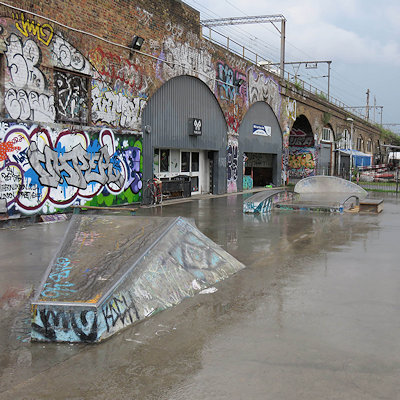
Like us on Facebook
PLACE NAMES


 
|
|
Mile End
|

|
|
|
Mile End is recorded in 1288 as La Mile ende. It is formed from the Middle English 'mile' and 'ende' and means 'the hamlet a mile away'. The mile distance was in relation to Aldgate in the City of London, reached by the London to Colchester road. In around 1691 Mile End became known as Mile End Old Town because a new unconnected settlement to the west and adjacent to Spitalfields had taken the name Mile End New Town. This data combines the ethnicity data for Mile End's two wards (Mile End And Globe Town and Mile End East).
Mile End Road is an ancient route from London to the East, and was moved to its present-day alignment after the foundation of Bow Bridge in 1110. In the medieval period it was known as 'Aldgatestrete', as it led to the eastern entrance to the City of London at Aldgate. The area running alongside Mile End Road was known as Mile End Green, and became known as a place of assembly for Londoners, reflected in the name of Assembly Passage. For most of the medieval period, this road was surrounded by open fields on either side, but speculative developments existed by the end of the 16th century and continued throughout the 18th century.
The Stepney Green Conservation Area was designated in January 1973, covering the area previously known as Mile End Old Town. It is a large Conservation Area with an irregular shape that encloses buildings around Mile End Road, Assembly Passage, Louisa Street and Stepney Green itself. It is an area of exceptional architectural and historic interest, with a character and appearance worthy of protection and enhancement. It is situated just north of the medieval village of Stepney, which was clustered around St. Dunstan’s Church.
In 1381, an uprising against the tax collectors of Brentwood quickly spread first to the surrounding villages, then throughout the South-East of England, but it was the rebels of Essex, led by a priest named Jack Straw, and the men of Kent, led by Wat Tyler, who marched on London. On 12 June, the Essex rebels, comprising 100,000 men, camped at Mile End and on the following day the men of Kent arrived at Blackheath. On 14 June, the young king Richard II rode to Mile End where he met the rebels and signed their charter. The king subsequently had the leaders and many rebels executed.
Mile End is in a part of London known as the East End and home to the main campus of Queen Mary, University of London. Parts of Barts and The London School of Medicine and Dentistry are also based on this campus. The main student halls of residence are also now located on this campus.
The neighbourhood was immortalised (humorously but unfavourably) in the pop band Pulp's song, "Mile End," which was featured on the Trainspotting soundtrack. The song describes a group of squatters taking up residence in an abandoned 15th-floor apartment in a run-down apartment tower.
A man pushed in front of a train at Mile End underground station recently attracted media attention and has resulted in an acclaimed play, called "Mile End," devised and performed by Analogue Theatre.
In 2009, the music video for "Confusion Girl" by electropop musician Frankmusik was filmed in Mile End Park and Clinton Road, Mile End.
In 2011, the music video for "Heart Skips a Beat" by Olly Murs and Rizzle Kicks was filmed in Mile End's skate park.
The artistic director of the 2012 Summer Olympics opening ceremony, Danny Boyle, lives in Mile End. Boyle is also the director of Trainspotting.
|
 Feel free to Email me any additions or corrections Feel free to Email me any additions or corrections
LINKS AVAILABLE TO YOUR SITE
| |





